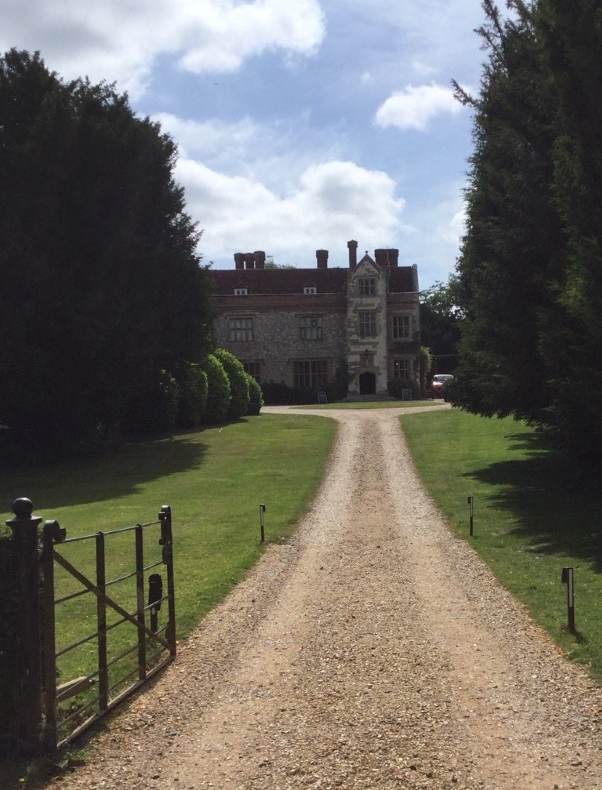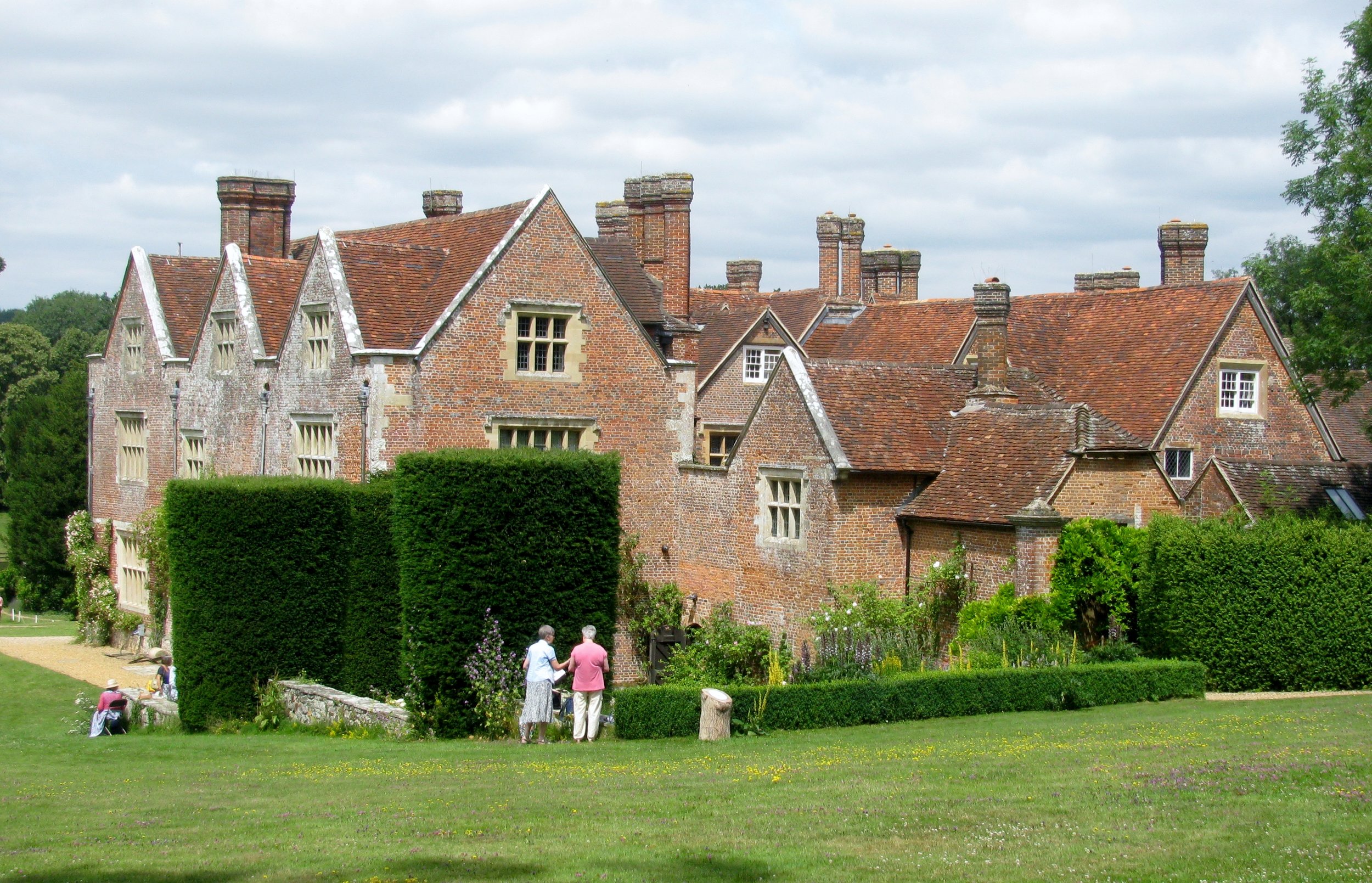Come join me in a tour of Austen family homes as Fanny came to know them. First, this month to Chawton Cottage and Chawton House in Hampshire and next month to Godmersham Park in Kent.
Soon after her arrival in England in July 1811, Fanny made the first of several visits to Chawton, a small village in Hampshire about 52 miles southwest of London. She travelled through lovely countryside composed of woods, sheltered valleys, hop fields, lanes and downs.[1] On August 8th Fanny, Charles and their two children arrived at Chawton Cottage. Here she met the widowed Mrs George Austen and her daughters, Cassandra and Jane, for the first time.
Fig. 1: View of Chawton Cottage today
Fig. 2: Dining Room at the Cottage
Originally an 18th century farm house, the Cottage had been recently renovated. To Fanny’s eye, it must have looked inviting, set off by an attractive garden, which included shrubberies made by adding ornamental plants, such as lilac and herbaceous plants to the existing hedgerows. The women immediately warmed to Fanny and the children, Cassy (age 2½) and Harriet (1½) , and they were delighted to welcome Charles after an absence of over 6½ years while he was serving on the North American Station of the Royal Navy. Cassandra described Fanny as “a very pleasing little woman, she is gentle and amiable in her manners and appears to make [Charles] very happy,”[2] words which suggest that Fanny passed muster with the Chawton Cottage family from the very beginning.
Besides the happy busyness of a family visit, this would have been an occasion for Charles and Fanny to share some of their experiences in the North American naval world they had recently left. Austen scholar Brian Southam pictures the returned Charles, and presumably Fanny, as “regaling the Austens with stories of Bermuda and Halifax, [the major ports on the North American Station] and Charles’s successes in his vessel, the Indian.”[3] Fanny and Charles departed after an enjoyable visit of one week but their return was greatly anticipated. Cassandra, Jane and Mrs Austen welcomed “Charles and his pretty little wife [back to the Cottage] early in the winter.” In Cassandra’s words: “Charles and his Fanny came to us for a few days previous to taking possession of their aquatic abode [aboard HMS Namur].”[4]
Fig. 3: The Great House, front approach.
Living primarily at sea from 1812-1814 meant that Fanny and her family had reduced opportunities to make shore-based visits into Hampshire, but they did go again to Chawton in May 1813. They stayed at the Cottage but frequently socialized with several of their immediate relatives, who were staying at the mansion house, [5] where Charles’s brother Edward Knight was in temporary residence with his own large family. Edward had been adopted as an adolescent by wealthy childless cousins, Thomas and Catherine Knight. As their heir, he had come into possession not only of Chawton Great House and its estate but also Godmersham Park in Kent.
Chawton Great House had its origins in Elizabethan times but was subsequently much altered by generations of Knights. The house retained aspects of its early construction and decoration so that Fanny could admire some of its original sixteenth-century features, such as a fireplace backed with herringbone brickwork and the richly carved oak panelling in the Great Hall and Dining Room. Edward’s fourteen-year-old daughter, Fanny Knight, on first seeing the Great House in 1807, described it as “a fine large house [with] such a number of old irregular passages etc. that it is very entertaining to explore them, and often when I think myself miles away from one part of the house I find a passage or entrance close to it, & I don’t know when I shall be quite mistress of all the intricate, and different ways.”[6] Perhaps Fanny Austen explored the interesting complexities of the house with Fanny Knight as her guide.
Fig. 4: Chawton House, side view.
During Fanny’s two and a half weeks in Chawton, she made many informal visits to the Great House, which was easily reached by following a path from the Cottage through the estate to the mansion house.
Fig. 5: Way across the fields from the Cottage to the Great House
Should it be a morning visit, the ladies usually gathered in the Oak Room.
Fig. 6: View from the window seat in the Oak Room.
Fig. 7: Fanny Palmer Austen’s Silhouette.
In a sense, Fanny has a continuing presence in this room even today as her silhouette, created by John Meirs between 1811 and 1814, hangs on the left-hand side of the fireplace.
More formal family events also occurred, such as the dinner on May 17th when Fanny, Charles, Jane, Cassandra and their friend, Martha Lloyd, dined at the Great House and enjoyed games in the evening. Perhaps those assembled played charades, a favourite pastime within the Austen family. On another occasion, according to Fanny Knight, they had a “merry” time playing “jeu de violin.”
Chawton also had a place in the lives of Fanny’s two oldest daughters, Cassy and Harriet. They spent most of June 1813 with their Aunts Cassandra and Jane at the Cottage. In both 1813 and 1814 they made winter visits there, for Fanny feared for her children’s well-being when cold winds, wet, foggy weather and the constant motion of the sea made life on board truly uncomfortable. Her eldest, Cassy, who was particularly prone to seasickness, made regular trips to Chawton even though Fanny hated being separated from her children.
Fig. 8: Quilt made by Jane, Cassandra and Mrs Austen displayed at the Museum
Fanny surely enjoyed the time she spent at Chawton. She experienced the conviviality of a large family gathering at the Great House and the attendant luxury of the Knight’s hospitality. The Cottage also offered a genuine welcome in a pleasing village with a rural setting and a chance for Fanny to become more intimately acquainted with her new sisters, Cassandra and Jane. Moreover, Chawton provided an escape from the confinement and loneliness, the cabin fever that was the fate of an officer’s wife living on a naval vessel riding at anchor at sea.
Today Chawton Cottage is the Jane Austen House Museum and has recently celebrated the 70th anniversary of its founding. The collection of artefacts associated with Jane Austen, her family and her novels is evocative and impressive.
The reconstruction of the garden to include plants which would have likely been in place when Jane was in residence greatly enhances the charm of the setting.
Fig. 9: The Cottage garden today
Chawton House is also a fascinating destination as an example of a Tudor mansion and estate, successively adapted and modernized over 500 years. Visitors can view the 15,000-volume library, which specializes in the works of early women writers, and walk in the restored Georgian garden and “wilderness,” while reflecting on the historic associations with the lives and times of Jane and Fanny Austen.
Learn more:
Photos by Hugh & Sheila Kindred, except Fig.1, courtesy of David Brandreth.
[1] The text in this blog is derived from my book, Jane Austen’s Transatlantic Sister, 78-81, 88, 121-23.
[2] Cassandra Austen to Phylly Walter, quoted in Austen Papers, ed. Richard A. Austen-Leigh, 251.
[3] See Brian Southam, “Jane Austen and North America: Fact and Fiction,” in Jane Austen and the North Atlantic, ed. Sarah Emsley, 26.
[4] Cassandra Austen to Phylly Walter, Austen Papers, 251
[5] The party included Charles’s brother Henry, his brother James’s wife, Mary, and their daughter, Caroline.
[6] Quoted in Deirdre Le Faye, Fanny Knight’s Diary, 12.





























